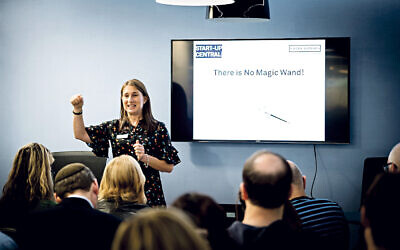Concentration camp barracks to be displayed at new IWM Holocaust gallery
Museum bosses have unveiled details of the £30m project and announced it will open on 20 October.

Part of a concentration camp barracks will go on display for the first time in the UK as part of the Imperial War Museum’s new Holocaust Gallery set to open this autumn.
The artefact is likely the last remaining part of Velten, a sub-camp of Ravensbrück and Sachsenhausen, which housed Jewish, Roma and Sinti women, and political prisoners of various nationalities.
In a £30.7m project, alongside the Holocaust Gallery will be a Second World War Gallery, making the IWM the first museum in the world to have dedicated galleries to the two subjects under the same roof.
Among the major donors to the galleries are Chelsea’s owner, Roman Abramovich, who held a fundraising dinner for the project at the club in partnership with the Jewish News.

Photographed 20th April 2021.
They are set to open on 20 October, and have been almost seven years in the making.
As well as the barracks, the Holocaust Gallery will showcase more than 2,000 photos, books, artworks and letters to tell the story of the horror of the Shoah and the lives of its victims and survivors, and its connecting history with the War.
Speaking to Jewish News, senior curator on the Holocaust Gallery, Lauren Wilmott, revealed how the barracks had actually been part of someone’s house until being acquired by the museum.
“We know that two sisters ended with these pieces of the barracks and used it to build a house,” she said. “Given the housing shortages, it was kind of a case of using whatever materials you could get your hands on.”
She hopes it will shed light for many on the extent of the camp system. “Between 1933 and 1945, there were 44,000 camps established … in Linz, in Austria, there was one prisoner for every five inhabitants, and it kind of hits home how visible the camp system was. The idea that no-one knew what was happening just isn’t true.”

The gallery will use the latest research, including archive material only opened to the public since the end of the Cold War.
Other never-seen-before items include the wedding dress of Gena Turgell, a survivor of Belsen, who married a British officer who liberated her from the camp.
The delicate item, made from parachute silk, will serve to highlight that the effects of the Holocaust did not end when camps were liberated.
Another item out of the many which will move viewers is a coat, gifted by a father to his son, who was on the Kindertransport.
“We have a case of a child’s coat, a boy who was fourteen at the time, and his father bought it for the journey,” said Wilmott.
“He bought it several sizes too big, knowing that he was never going to see his son again, so that he would grow into it – it was a parting gift, almost.
“That’s a particularly moving one for me – it’s remembering that many of the parents were often not allowed to come with them, and many of them later ended up being murdered.”

Photographed 2nd and 3rd September 2020.
Before the opening, the museum is embarking on a fundraising drive of £250,000 which will go towards the conservation of the barracks and installation work that has yet to be completed.
Diane Lees, Director-General of the museum, said: “It has never been more important to learn about the Second World War and the Holocaust and to understand this defining period of the 20th century, which dramatically shaped the world we live in today.
“Though this conflict will soon pass out of living memory, leaving us without the first-hand testimony of its veterans, eyewitnesses and survivors, IWM will ensure that the experiences of those generations are never forgotten through our incredible new galleries, which have been almost seven years in the making.”

Thank you for helping to make Jewish News the leading source of news and opinion for the UK Jewish community. Today we're asking for your invaluable help to continue putting our community first in everything we do.
For as little as £5 a month you can help sustain the vital work we do in celebrating and standing up for Jewish life in Britain.
Jewish News holds our community together and keeps us connected. Like a synagogue, it’s where people turn to feel part of something bigger. It also proudly shows the rest of Britain the vibrancy and rich culture of modern Jewish life.
You can make a quick and easy one-off or monthly contribution of £5, £10, £20 or any other sum you’re comfortable with.
100% of your donation will help us continue celebrating our community, in all its dynamic diversity...
Engaging
Being a community platform means so much more than producing a newspaper and website. One of our proudest roles is media partnering with our invaluable charities to amplify the outstanding work they do to help us all.
Celebrating
There’s no shortage of oys in the world but Jewish News takes every opportunity to celebrate the joys too, through projects like Night of Heroes, 40 Under 40 and other compelling countdowns that make the community kvell with pride.
Pioneering
In the first collaboration between media outlets from different faiths, Jewish News worked with British Muslim TV and Church Times to produce a list of young activists leading the way on interfaith understanding.
Campaigning
Royal Mail issued a stamp honouring Holocaust hero Sir Nicholas Winton after a Jewish News campaign attracted more than 100,000 backers. Jewish Newsalso produces special editions of the paper highlighting pressing issues including mental health and Holocaust remembrance.
Easy access
In an age when news is readily accessible, Jewish News provides high-quality content free online and offline, removing any financial barriers to connecting people.
Voice of our community to wider society
The Jewish News team regularly appears on TV, radio and on the pages of the national press to comment on stories about the Jewish community. Easy access to the paper on the streets of London also means Jewish News provides an invaluable window into the community for the country at large.
We hope you agree all this is worth preserving.





















